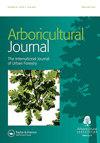Energy, fuel, and carbon
Q3 Agricultural and Biological Sciences
引用次数: 0
Abstract
Energy, fuel, and carbon all feature in this second issue of 2022. Dash, Pradhan, and Behera (2022) consider above-ground biomass of trees in urban parks of Bhubaneswar in India. They go on to estimate the potential carbon storage in these trees. Their research highlights the possible roles of urban greenspaces such as parks in helping to mitigate climate change drivers by storing carbon. They argue that this also provides impetus (along with other benefits) for urban planners to value such areas and to protect and enhance them. The context then switches to Ethiopia as Feyisa, Negash, and Melka (2022) examine the importance of “green infrastructure” in relation to woody plant diversity and carbon capacity in Hawassa city. The work indicated the importance of soil carbon stock in urban green infrastructure but also highlighted the predominance of exotic woody species. The authors advocate more use of appropriate native species in future planting schemes. Fitria, Cheong, Solikhin, Firdaus, and Ward (2022) researched issues of urban forest policies in Indonesia in relation to bioenergy potential of the various tree species. They conclude that a range of these tree species can be considered to have multipurpose functions to include: fuel for bioenergy, wood-based furniture, food and foraging, medicine, and many other uses. Along with producing firewood and charcoal, some of the trees could be utilised as biofuel for biogas, bio-pellet, and electricity generation. Furthermore, they suggest that this bioenergy potential of urban forest trees could help Indonesia energy-independent cities. These ideas might be transferable to other countries and regions.能源,燃料和碳
能源、燃料和碳都是2022年第二期的主题。Dash、Pradhan和Behera(2022)考虑了印度布巴内斯瓦尔城市公园树木的地上生物量。他们继续估算这些树木的潜在碳储量。他们的研究强调了公园等城市绿地通过储存碳来帮助缓解气候变化驱动因素的可能作用。他们认为,这也为城市规划者提供了动力(以及其他好处),使他们重视这些地区,并保护和加强它们。接着,Feyisa、Negash和Melka(2022)研究了“绿色基础设施”对阿瓦萨市木本植物多样性和碳容量的重要性。研究表明,土壤碳储量在城市绿色基础设施建设中的重要性,但也强调了外来木本物种的优势。作者主张在未来的种植计划中更多地使用适当的本地物种。Fitria, Cheong, Solikhin, Firdaus和Ward(2022)研究了印度尼西亚城市森林政策中与各种树种生物能源潜力相关的问题。他们的结论是,这些树种可以被认为具有多种用途,包括:生物能源燃料、木制家具、食物和觅食、医药和许多其他用途。除了生产木柴和木炭外,一些树木还可以用作沼气、生物颗粒和发电的生物燃料。此外,他们认为城市森林树木的这种生物能源潜力可以帮助印度尼西亚的能源独立城市。这些想法可以推广到其他国家和地区。
本文章由计算机程序翻译,如有差异,请以英文原文为准。
求助全文
约1分钟内获得全文
求助全文
来源期刊

Arboricultural Journal
Agricultural and Biological Sciences-Agronomy and Crop Science
CiteScore
2.40
自引率
0.00%
发文量
28
期刊介绍:
The Arboricultural Journal is published and issued free to members* of the Arboricultural Association. It contains valuable technical, research and scientific information about all aspects of arboriculture.
 求助内容:
求助内容: 应助结果提醒方式:
应助结果提醒方式:


